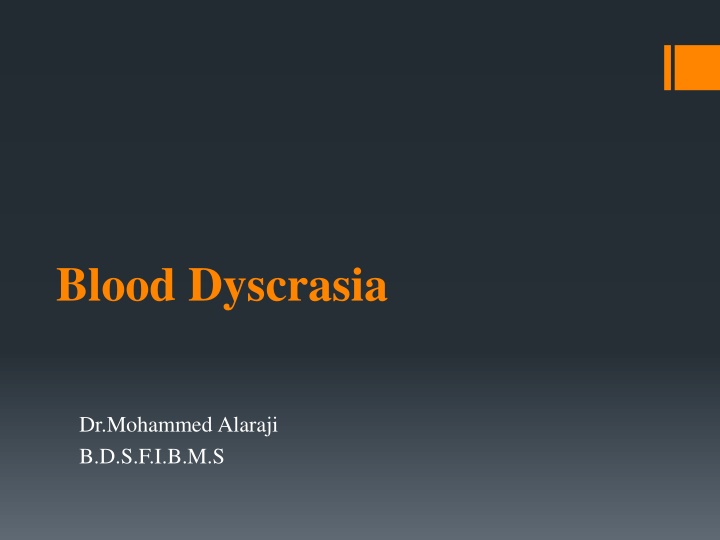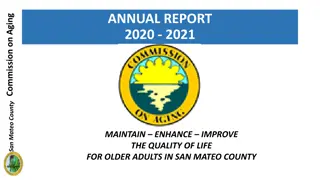
Understanding Blood Dyscrasia and Anemia Disorders
Learn about disorders of red and white blood cells, including anemia, its causes such as iron deficiency and hemolytic anemia, and the importance of key nutrients like Vitamin B12 and folate in red blood cell formation.
Download Presentation

Please find below an Image/Link to download the presentation.
The content on the website is provided AS IS for your information and personal use only. It may not be sold, licensed, or shared on other websites without obtaining consent from the author. If you encounter any issues during the download, it is possible that the publisher has removed the file from their server.
You are allowed to download the files provided on this website for personal or commercial use, subject to the condition that they are used lawfully. All files are the property of their respective owners.
The content on the website is provided AS IS for your information and personal use only. It may not be sold, licensed, or shared on other websites without obtaining consent from the author.
E N D
Presentation Transcript
Blood Dyscrasia Dr.Mohammed Alaraji B.D.S.F.I.B.M.S
These are grossly divided into; disorders of the red blood cells RBCs (erythrocytes) and disorders of the white blood cells WBCs.
Disorders of the RBCs Anemia Anemia, which is defined as a reduction in the oxygen carrying capacity of the blood, is usually associated with a decreased number of circulating RBCs or an abnormality in the Hb contained within the RBCs.
three underlying causes: (1) Decreased production of RBCs (iron deficiency, pernicious anemia, folate deficiency). (2) blood loss. (3) Increased rate of destruction of circulating RBCs (hypersplenism, autoimmune destruction).
Hb is a heterogeneous group of proteins consisting of 4 globin chains and 4 haem (heme) groups.In anemia Hb level is below 12 g/dl in adult female and below 13 g/dl in adult male.
Types of anemia: 1-Iron deficiency anemia is a microcytic anemia that can be caused by excessive blood loss, poor iron intake, poor iron absorption, or increased demand for iron. Blood loss may be caused by menses or bleeding from the gastrointestinal tract. Poor intake is more common in children who live in developing countries. Malabsorption of iron can result from gastrectomy or intestinal disease that reduces absorption of iron from the duodenum and the jejunum.
2-Folate DeficiencyAnemia and PerniciousAnemia Vitamin B12 (cobalamin) and folic acid are needed for red blood cell formation and growth within bone marrow. Vitamin B12 is a required of protein synthesis and thus in the maturation of RBCs. Folate is needed for enzymatic reactions required for the synthesis of (DNA) and (RNA) and thus for the synthesis of proteins. A deficiency in daily intake (as in chronic alcoholism) or absorption of these vitamins can result in anemia. Pernicious anemia is caused by a deficiency of intrinsic factor, a substance secreted by the stomach parietal cells that is necessary for absorption of vitamin B12.
3-HemolyticAnemia Hemolytic anemias are premature destruction of erythrocytes. caused by immune attack, extrinsic factors (infection, splenomegaly, drugs), and hemoglobinopathies (sickle cell anemia, thalassemia).
4-Sickle CellAnemia Sickle cell disease (SCD) and its variants are genetic disorders resulting from the presence of a mutated form of hemoglobin(HgS). The thalassemias, another type of hemoglobinopathy, are caused by deletions or mutations of the or globin gene that result in a defect in globin synthesis (reduced or absent synthesis of one or more globin chains).
Renal Disease. The kidney produces the hormone erythropoietin, which stimulates RBC production by the bone marrow. If significant renal damage occurs, lack of production of this hormone results in anemia. Patients who have chronic renal failure and are on dialysis often have anemia and low erythropoietin levels. Erythropoietic drug therapy is offered to these patients.
CLINICAL PRESENTATION symptoms include fatigue, palpitations, shortness of breath, abdominal pain, bone pain, tingling of fingers and toes, and muscular weakness. Signs of anemia may include jaundice, pallor, cracking, increased size of the liver and spleen, lymphadenopathy, and blood in the stool. Premature graying of hair .with pernicious anemia Patients with anemia may also describe a sore or painful tongue (glossitis), a smooth tongue, or redness of the tongue or cheilosis . Some patients may complain of loss of taste sensation.
Laboratory tests a complete blood count or referred to a physician for evaluation. Hb level, hematocrit, and RBC indices (mean corpuscular volume [MCV]. mean corpuscular hemoglobin [MCH], and mean corpuscular hemoglobin concentration[MCHC]) are tests that are used to screen the patient. In addition, total white blood cell (WBC) count and platelet count should be obtained to determine whether a generalized bone marrow defect has occurred. Anemia is generally defined as Hb < 12 g/dL for women and < 13 g/dL for men.
MEDICAL MANAGEMENT i. The goal of treatment is to eliminate the underlying cause. ii. (iron deficiency), iron supplements (ferrous sulfate)or ferrous gluconate). iii. Folate deficiency is managed by administering folic acid supplements . iv. Sickle cell anemia is based on routine prophylactic penicillin for infants and the early use of antibiotics to prevent severe infection. folic acid dietary supplements are given daily to most patients with sickle cell anemia. v. Bone marrow transplantation (BMT) has been used in children with sickle cell anemia and has met with moderate success. vi. Patients with chronic renal failure often requires dialysis and long-term use of recombinant erythropoietin. vii. Blood Transfusion with RBCs is reserved for patients who are actively bleeding.
Dental management The following preventive measures are necessary for patients with a history of anemia and who need to have a tooth extracted: Hematocrit and hemoglobin levels must be as near normal as possible and consultation with the patient s hematologist is often necessary. Patients with sickle cell anemia in particular must avoid: Pain and severe stress, otherwise a sickle cell crisis might result. - Premedication and pain control with anesthetics that cause profound anesthesia are recommended. Abrupt awkward manipulations during the extraction; due to osteoporosis caused by the disease, there is increased risk of fracture of the mandible. As contraindications for patients with anemia. far as local anesthetics are concerned, there are no
Polycythemia It is an expansion mainly in the red cell population, it may be primary and idiopathic associated with normal erythropoietin level (Polycythemia Rubra Vera) PRV. It can also be secondary to tumors that release erythropoietin hormone. PRV is a disease of elderly and of smokers; it has a slight male predilection. Diagnosis of Polycythemia is made when Hb level is above 16.5 g/dl and hematocritvalue (PCV) 48% in women and when Hb is above 18.5 g/dl and hematocrit 52% in men.
Clinical presentation Hyperviscosity of blood leading to thrombosis due to changes in platelets and clotting mechanisms which may cause Stroke and Myocardial Infarction. Pruritus. Hemostatic defects. Bone pain due to replacement of bone marrow with erythropoietic tissues.
General management Repeated venesection which involves blood letting or drawing of blood as in donation of blood. Cytotoxic drugs (Busulphan, Chlorambucil or Melphalan) may be given to suppress marrow activity.
Dental management LA regional blocks should be avoided if possible. Conscious sedation can be given. GA is allowed. Susceptibility to thrombosis and hemorrhage should be considered. Cytotoxic chemotherapy may cause oral complications that require management.
Leukemia Leukemia is a pathologic condition of neoplastic nature, characterized by quantitative and qualitative defects of circulating white cells. Depending on the duration of the disease, it is classified as acute or chronic, and, according to the leukopoietic tissue that is involved, as myelogenous or lymphocytic. Patients with leukemia must be treated with special care and always under consultation with the patient s hematologist, because these patients are susceptible to severe infection and postoperative hemorrhage.
There are 4 types of leukemia with many subtypes 1. Acute Lymphoblastic Leukemia ALL, it is the most common type in children. 2. Acute Mylogenous Leukemia AML, the most common type in adults. 3. Chronic Lymphocytic Leukemia CLL, the second most common type in adults. 4. Chronic Myloid Leukemia CML.
Clinical presentation Include; fatigue, easy bruisibility, bone pain, anemia, thrombocytopenia, malaise, pallor, anorexia, dyspnea on exertion, bleeding tendency, petechiae and ecchymoses of the skin and mucous membrane, recurrent infections, fever, weight loss, LAP, enlargement of the spleen and CNS disease. Diagnosis is made by examination of the peripheral blood and bone marrow.
General management It consists of chemotherapy to reduce the number of the malignant WBCs. The other line of treatment is bone marrow transplantation and peripheral blood stem cell transplantation.
Oral manifestations Are more common in acute leukemia than in chronic leukemia, they include: Localized or generalized gingival enlargement . The gingiva bleeds easily, sometimes spontaneously oral hygiene measures and chemotherapy may cause resolution. Oral ulcerations. Recurrent oral infections, due to the immature WBCs and as a complication of chemotherapy. Pallor of oral mucosa. LAP(Lymph adenopathy).
Dental management Avoidance of nerve block (only if anesthesia of the area is possible with local infiltration) because, due to the blood cell disorder, extensive hematoma may result. Surgical procedures (e.g., tooth extraction) may be performed in a hospital, with administration of large doses of a broad-spectrum antibiotic. Antibiotic prophylaxis should be administered.
Lymphoma Lymphoma is a solid malignant tumor that originate in the lymph nodes or extranodal lymphoid tissues in any part of the body. Lymphoma comprises Hodgkin's lymphoma or disease and non- Hodgkin's lymphoma NHL. NHL is more common than the Hodgkin's type. The clinical presentation include: LAP, fever, weight loss, abdominal or chest pain , extranodal tumors &night sweats, fatigue. The diagnosis is based on biopsy of the lymph nodes or extranodal tumor. Proper staging is required which consists of blood investigation, imaging and bone marrow biopsy. Medical management of lymphoma generally consist of chemotherapy and radiotherapy.
Multiple Myeloma It is a lymphoproliferative disorder that results from overproduction of cloned malignant plasma cells resulting in bony lesions involving the skeletal system. Clinical presentation The malignant cell proliferation cause bone resorption that appear radiographically as a radiolucent punched out lesions and replace bone marrow leading to anemia, leukopenia, thrombocytopenia. There is Amyloid deposition in various tissues that may lead to renal failure. Infection is common. The most prominent symptom is persistent bone pain affecting the spine, ribs and sternum, weight loss, headache and Hypercalcemia.
Dental management of patients with diagnosed Leukemia, Lymphoma and Multiple Myloma It involves the three phases of the medical therapy 1. Pretreatment assessment and preparation of the patient: Full knowledge of the patient's condition is required, the aim of this phase is to prevent oral infections, all potential sources of infection must be eliminated. 2. Oral health care during medical treatment: During treatment the patient is susceptible to many oral complications that require care: Mucositis; appear 7-10 days after initiation of treatment and resolve after it. The non-keratinized mucosa is more severely affected. Oral hygiene measures should be maintained to minimize infection, antiseptic and antimicrobial mouth washes e.g. Chlorhexidin are recommended. Bleeding; thrombocytopenia Neutropenia and Infection; neutropenia leads to gingival inflammation, oral ulceration and infection which can be severe but with minimal clinical signs.
3. Post treatment management When invasive procedures are planned (e.g. oral surgery), platelet count and bleeding time should be investigated, the patient's physician should be consulted. In patients with surgically removed spleen, prophylactic antibiotic is needed In patients with acute symptoms, routine dental care should be deferred. LA regional block should be avoided if possible in patients with bleeding tendency.






















